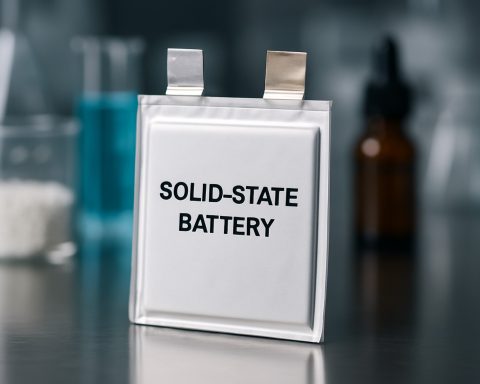- Solid-ion conductors are revolutionizing energy storage, paving the way for efficient and safer solid-state batteries.
- The market for solid-ion conductors is projected to grow from $22.3 million in 2022 to $46.8 million by 2031 at an 11.2% annual growth rate.
- Key drivers include the burgeoning demand for electric vehicles and advancements in solid-state battery technologies.
- Solid-ion conductors offer enhanced safety, improved stability, and increased energy density compared to traditional liquid electrolytes.
- Beyond automotive, these materials benefit the electrical and engineering sectors, crucial for smaller, more powerful batteries and sensors.
- Research and development in novel materials like solid polymers and lithium ionic conductors fuel market adoption.
- Regionally, North America and Asia Pacific are leading in adoption and innovation due to strong tech landscapes and industrial demands.
- Companies such as Cymbet Corporation and Prieto Battery are at the forefront of this technological evolution.
Behold the pulsating heart of the technological revolution—a new generation of solid-ion conductors that promise to vault our energy storage technologies into a future bursting with potential. Imagine a world where your morning commute is powered by a car that not only hums with the tranquility of electric power but also bristles with the unmatched efficiency of solid-state energy. This reality may soon be at hand, as the solid-ion conductors market is poised for a meteoric rise from a modest $22.3 million in 2022 to a striking $46.8 million by 2031, growing steadily at an annual rate of 11.2%.
These ingenious materials, the maestros of the ionic world, orchestrate ion flow through their intricate solid matrices, bypassing the need for traditional liquid electrolytes. The result? Enhanced safety, improved stability, and staggering energy densities—all vital ingredients in the recipe for cutting-edge batteries that move beyond conventional limitations. It’s no wonder that tech giants and automakers like Tesla and Toyota have shifted gears, channeling hefty investments into the development of these solid-state miracles.
As we delve into the meat of the solid-ion conductors market, we find it driven by the insatiable thirst for electric vehicles (EVs). The automotive industry races toward a sustainable tomorrow, and it needs batteries that can keep pace. Solid-state batteries, with their promise of denser energy and a fortress-like safety, have emerged as the leading torchbearers. But the allure of solid-ion conductors extends beyond the driveway.
The electrical and engineering sectors are equally enamored. As industrial applications demand ever-more efficient energy solutions, solid-ion conductors step forward. They’re the backbone of ever-smaller and more powerful batteries and sensors, finding their roles in everything from consumer electronics to the lofty realms of neuromorphic computing.
The lanes of innovation are well-paved, courtesy of robust research and development efforts. Novel materials are springing forth, each with a tantalizing promise—be they solid polymers or lithium ionic conductors, each a step closer to overcoming current limitations. This smorgasbord of new materials propels market adoption across diverse sectors, signaling a technological evolution that’s hard to ignore.
Geographically, North America reigns supreme, a testament to its robust high-tech landscape and rapid embrace of EVs. Asia Pacific is hot on its heels, teased by rapid industrialization and an unquenchable demand for green and smart technologies in powerhouses like China and India.
Prominent voices in this arena—think Cymbet Corporation and Prieto Battery—headline the charge with audacious R&D and scaling-up initiatives, crafting a narrative of innovation that’s as relentless as it is exciting.
For the curious minds keeping tabs on the pulse of sustainable energy solutions, one thing stands out: solid-ion conductors aren’t just interacting with electrons and ions. They’re interacting with the very fabric of the future, molding it to fit a vision of sustainability that’s not only cleaner but smarter. In this unfolding saga, they are the silent revolutionaries, quietly but radically changing the trajectory of energy solutions for years to come.
Unlock the Future: Solid-Ion Conductors and Their Impact on Energy Revolution
Expanding on Solid-Ion Conductors and Their Impact
Solid-ion conductors are truly at the heart of the next wave of technological advancements in energy storage. Their ability to transport ions through solid matrices without the need for liquid electrolytes is revolutionizing battery technology. Here, we delve deeper into various facets of these materials that promise to shape the future of energy storage.
How Solid-Ion Conductors Work
At the core, solid-ion conductors utilize a solid matrix as a medium to facilitate the movement of ions. This process is key in the function of solid-state batteries, which offer several advantages over traditional lithium-ion batteries. These include:
– Improved Safety: Solid-state batteries significantly reduce the risk of leaks, which is a common issue with liquid electrolytes. They also decrease the likelihood of thermal runaway, a leading cause of battery fires.
– Enhanced Energy Density: These materials allow for more ions to be packed into a battery, increasing both storage capacity and the range for electric vehicles.
Market Forecasts & Industry Trends
As solid-ion conductors integrate into various market segments, the forecast for this industry appears promising:
1. Electric Vehicles: There is a clear trend towards EVs, driven by the need for sustainability and the reduction of carbon emissions. Solid-ion conductor technology is vital for the widespread adoption of EVs due to its ability to provide longer range and faster charging times.
2. Consumer Electronics: These conductors lead to longer-lasting batteries in devices such as smartphones and laptops, which is highly attractive for companies aiming to extend the lifespan of their products.
3. Energy Storage Systems: The demand for efficient energy storage solutions in power grids is rising, and solid-state batteries could play a crucial role in stabilizing renewable energy sources.
Limitations and Challenges
While the outlook is optimistic, there are challenges and limitations:
– High Cost of Production: Solid-state batteries can be expensive to produce at scale due to the complexity of the materials used.
– Material Innovations: Continuous research is required to find materials that can offer even better performance and lower costs.
Security & Sustainability
Solid-ion conductors enhance both the security and sustainability aspects of energy technologies:
– Environmental Impact: Reducing reliance on hazardous liquid electrolytes helps mitigate potential environmental risks.
– Resource Efficiency: By enabling higher efficiency, these batteries can decrease the consumption of non-renewable resources.
Real-World Use Cases
– Automotive Industry: Companies like Tesla and Toyota are investing heavily in solid-state battery technology to create next-generation EVs with unprecedented range and safety.
– Wearable Technology: Solid-state batteries are being used in the development of smaller, more efficient wearables, enhancing performance without compromising on design.
Pros & Cons Overview
Pros:
– Increased safety and reduced risk of leaks.
– Higher energy density translates to longer use time.
– Reduction in environmental impact.
Cons:
– High manufacturing costs.
– Need for further development to improve efficiency.
Quick Tips and Action Points
– Stay Informed: Keeping up with developments in solid-ion conductor technology can help you anticipate shifts in the energy and consumer electronics markets.
– Invest Strategically: Organizations looking to invest in future technologies should consider solid-state tech as part of their long-term strategy.
– Adopt Early: For consumers and businesses, early adoption of solid-state technology may offer competitive advantages, especially in the automotive and electronics sectors.
For more captivating insights into technological advancements, visit the Forbes website to stay updated.










